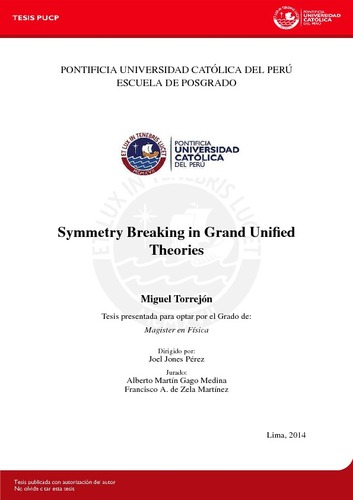Symmetry breaking in grand unified theories
Abstract
In this work we review the symmetry breaking mechanism of gauge theories. On the first chapters of this thesis, we review the concept of symmetry as the action of a group that leaves an object invariant, in particular Lagrangians and actions, and then develop the corresponding globally and gauge symmetric theories and the relationship between them. It also reviewed the concept and general framework of the spontaneous breaking of a symmetry for renormalizable potentials. Correspondingly, two main results for global symmetries, Noether’s theorem and Goldstone’s Theorem, are reviewed in a general setting.
Chapter 3 is the most important part of this work. The Brout-Englert-Higgs mechanism is explained and used to retrieve the symmetry breaking patterns for the vector and all the second rank tensor irreducible representations of the O(n) and SU(n) groups. In general we will retrieve the vacuum expectation value (vev) for the particular representation and value of the parameters of the potential. Then, for this vev, we calculate the number of massive vector bosons of the theory. Following BEH mechanism and Goldstone’s theorem, this number is equal to the number of broken generators delining thus the particular symmetry breaking pattern.
Chapter 4 is a review of the Standard Model with an aim towards Grand Unified Theories (GUTs). Lastly in Chapter 5 we review the group theory of the minimal model SU(5) in a very exhaustive way and use the results of Chapter 3 to see the breaking patterns for this particular GUT.
Temas
Simetría (Física)
Invariantes
Invariantes
Para optar el título de
Maestro en Física
Collections
The following license files are associated with this item:






